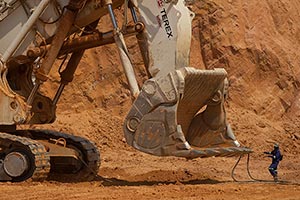Construction Equipment Firm Terex Frets Over Possible Layoffs, Facility Closures

The CEO of Terex suggested Nov. 1 the company will see more layoffs, facility closures and business sales in the coming year as he works to simplify the heavy-equipment maker’s operations and position it for growth should the economy pick up steam.
Nov. 2 marks CEO John Garrison Jr.’s one-year anniversary with Terex, the Westport, Connecticut-based manufacturer of vehicles and equipment for construction and material handling, including aerial work platforms, boom cranes and machines to shred or crush debris. Despite third-quarter revenue that was off 16% from a year earlier to less than $1.1 billion, Terex profits rose 10% to $33.3 million, or 31 cents a share.
Terex had been run since 1993 by Ron DeFeo, who took over a company with fewer than 2,800 employees largely in four states and three countries, and through a buying binge built it into a giant with 21,000 workers at the peak of the last economic cycle, competing with bedrock industry icons such as Caterpillar and John Deere.
Garrison joined the company from the Bell Helicopter division of Providence, Rhode Island-based Textron; he grew up the son of a U.S. Air Force pilot before enrolling at the U.S. Military Academy at West Point, serving as a U.S. Army Ranger and obtaining an MBA from Harvard Business School.
Under Garrison, Terex finds itself in the same fix as it did under DeFeo in 1993 — dealing with an economy still shaky from the most recent recession and with volatile energy markets discouraging new equipment purchases in that sector. Garrison also has been working to extricate Terex from a scrapped merger with Finnish firm Konecranes, instead selling a division that makes big forklifts and overhead cargo cranes for ports and industrial plants.
Both companies have been hit hard by crane demand globally, with Garrison telling investors in a Nov. 1 conference call that it is the company’s only division in which plants are working a single shift. That prompted Terex this past summer to move a crane production plant to Oklahoma City from Waverly, Iowa, where the company had a presence dating to DeFeo’s arrival, at a cost of 175 jobs, and Garrison said the company is looking at other facilities that are being underused.
“I recently had a business meeting with one of our larger customers, and he was saying how he had moved here recently 100 cranes that were basically sitting idle in the tar sands area of Canada,” Garrison said Nov. 1. “In the cycle for cranes in North America ... we’d like to believe we’re bumping along at the bottom of the trough.”
Its name coined as a derivative of the words terra and rex (earth king), Terex was created in 1970 as a brand of General Motors after the Detroit giant caved to federal antitrust pressure to sell off its Euclid division that made massive dump trucks while retaining rights to sell them internationally. Founded in 1909 in Ohio by George Armington, Terex’s predecessor company, Euclid, had been acquired by GM in 1953 for $20 million, at the time employing 1,600 people.
GM would sell Terex in 1981 to German firm IBH but in just a few years would reabsorb the division after IBH declared bankruptcy. In 1986, Green Bay, Wisconsin-based Northwest Engineering bought Terex, with the company then spun off in a 1991 initial public offering of stock. After the 1991 death of its previous CEO, Terex hired DeFeo the following year and in 1993 installed him in the corner office.
From there, Terex would bolt on buy after buy as it took advantage of two big economic booms to expand its platform to aerial lifts (in September the company marked in Seattle the 50th anniversary of its Genie line), cranes and assorted other machines — even small, tracked vehicles designed to soldier through snow or swamp.
For Garrison, the job now is to find Terex’s track through its current morass to growth. As for investors, they seem to think he is on the right path. Even after falling 4% Nov. 1 after the company’s third-quarter results, Terex shares are up nearly $2 in Garrison’s first year on the job to about $23. Garrison said he would share more about the company’s restructuring at a December investor conference.
“Clearly, you are going to hear more about restructuring activities in the crane side as we attack the underlying footprint,” Garrison said. “It’s not just physical assets but it’s also on the people side — unfortunately.”
Distributed by Tribune Content Agency, LLC

